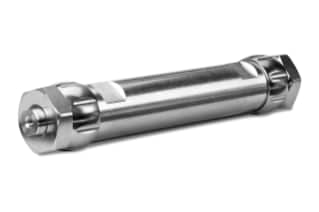
|
Chemistry |
C18 |
|
Separation Mode |
Reversed Phase |
|
Particle Substrate |
Hybrid |
|
pH Range Min |
1 pH |
|
pH Range Max |
12 pH |
|
Temperature Limits |
80 C (Low pH)/60 C (High pH) |
|
Maximum Pressure |
6000 psi (415 Bar) |
|
Endcapped |
Yes |
|
Silanol Activity |
Low |
|
Particle Shape |
Spherical |
|
Particle Size |
5 µm |
|
Endfitting Type |
Waters |
|
Pore Size |
130 Å |
|
Format |
OBD Prep Column |
|
Surface Area |
185 |
|
System |
HPLC Preparative |
|
Particle Technology |
BEH |
|
Technique |
LC, LC/MS |
|
USP Classification |
L1 |
|
Inner Diameter |
19 mm |
|
Length |
150 mm |
|
Carbon Load |
18 % |
|
UNSPSC |
41115709 |
|
Brand |
XBridge |
|
Product Type |
Preparative Columns |
|
Units per Package |
1 pk |

XBridge BEH C18 OBD Prep Column, 130Å, 5 µm, 19 mm X 150 mm, 1/pk
For chromatographers looking to increase productivity through higher recoveries and longer column lifetimes, XBridge BEH C18 OBD Prep Columns use Waters’ Optimum Bed Density technology to enable fast, efficient, lab-scale separations for greater throughput and the ability to directly scale from UPLC, UHPLC, or HPLC screen to lab-scale purification. XBridge BEH C18 OBD Prep Columns eliminate inconsistencies in column-to-column performances while improving column lifetimes, preventing lost samples, repeat purification runs, and poor scalability.
The XBridge BEH C18 sorbent is a known workhorse for HPLC method development and can be used over an entire range of mobile phase pH (1 to 12). The trifunctionally bonded C18 ligand is the base of this universal column for most HPLC separations, giving chromatographers the widest usable pH range, superior pH stability, and ultra-low column bleed. The design of OBD technology exhibits exceptional resistance to mechanical chromatographic bed failure, delivering consistent performance and reducing cost through extended lifetimes, eliminating the cost of replacing lab equipment. Reproducibility can be further verified using the Preparative Chromatography Mix Standard from Waters.
OBD Preparative Columns are packed to specific bed densities to closely match the equivalent analytical column, an innovative procedure that produces preparative columns with exceptional stability, reproducibility, and efficiency. This allows for easy scaling. XBridge BEH C18 OBD Prep Columns also give access to Waters’ OBD Preparative Columns calculator, a convenient scale-up tool that provides mass load scaling, gradient scaling with appropriate flow rate scale-up and predicting volume consumption, calculations for split flow rations when using MS driven chromatography, and focused gradient UPLC or UHPLC to preparative method transfer.
How Do I Choose The Right OBD Preparative Column?
Once your analytical separation has been optimized, a loading study on the analytical column is performed and used to determine the capacity of the particular packing material. The large-scale separation should be identical to the small-scale separation, meaning the maximum sample load is dependent on the complexity of the analytical separation. You can then determine how much mass you need to purify or isolate. You can then reference simple equations, such as the scale-up factor, flow rate, and gradient duration, in order to determine the required column size for purification.